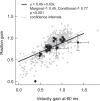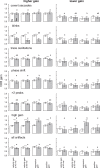VOR gain calculation methods in video head impulse recordings
- PMID: 32804110
- PMCID: PMC9037838
- DOI: 10.3233/VES-200708
VOR gain calculation methods in video head impulse recordings
Abstract
Background: International consensus on best practices for calculating and reporting vestibular function is lacking. Quantitative vestibulo-ocular reflex (VOR) gain using a video head impulse test (HIT) device can be calculated by various methods.
Objective: To compare different gain calculation methods and to analyze interactions between artifacts and calculation methods.
Methods: We analyzed 1300 horizontal HIT traces from 26 patients with acute vestibular syndrome and calculated the ratio between eye and head velocity at specific time points (40 ms, 60 ms) after HIT onset ('velocity gain'), ratio of velocity slopes ('regression gain'), and ratio of area under the curves after de-saccading ('position gain').
Results: There was no mean difference between gain at 60 ms and position gain, both showing a significant correlation (r2 = 0.77, p < 0.001) for artifact-free recordings. All artifacts reduced high, normal-range gains modestly (range -0.06 to -0.11). The impact on abnormal, low gains was variable (depending on the artifact type) compared to artifact-free recordings.
Conclusions: There is no clear superiority of a single gain calculation method for video HIT testing. Artifacts cause small but significant reductions of measured VOR gains in HITs with higher, normal-range gains, regardless of calculation method. Artifacts in abnormal HITs with low gain increased measurement noise. A larger number of HITs should be performed to confirm abnormal results, regardless of calculation method.
Keywords: HIT device; VOR; area under the curve; artifacts; calculation methods; gain; position gain; regression; regression gain; vHIT; video head impulse test; video-oculography.
Conflict of interest statement
None
Figures




Similar articles
-
Impact of artifacts on VOR gain measures by video-oculography in the acute vestibular syndrome.J Vestib Res. 2016 Nov 3;26(4):375-385. doi: 10.3233/VES-160587. J Vestib Res. 2016. PMID: 27814312 Free PMC article.
-
Age dependent normal horizontal VOR gain of head impulse test as measured with video-oculography.J Otolaryngol Head Neck Surg. 2015 Jul 4;44(1):29. doi: 10.1186/s40463-015-0081-7. J Otolaryngol Head Neck Surg. 2015. PMID: 26141721 Free PMC article.
-
Age adjusted normative data for Video Head Impulse Test in healthy subjects.Am J Otolaryngol. 2021 Nov-Dec;42(6):103160. doi: 10.1016/j.amjoto.2021.103160. Epub 2021 Jul 23. Am J Otolaryngol. 2021. PMID: 34315046
-
Video head impulse test: a review of the literature.Eur Arch Otorhinolaryngol. 2017 Mar;274(3):1215-1222. doi: 10.1007/s00405-016-4157-4. Epub 2016 Jun 21. Eur Arch Otorhinolaryngol. 2017. PMID: 27328962 Review.
-
Video Head Impulse Testing.Adv Otorhinolaryngol. 2019;82:56-66. doi: 10.1159/000490272. Epub 2019 Jan 15. Adv Otorhinolaryngol. 2019. PMID: 30947183 Review.
Cited by
-
The vertical computerized rotational head impulse test.J Vestib Res. 2024;34(1):29-38. doi: 10.3233/VES-230121. J Vestib Res. 2024. PMID: 38393869 Free PMC article.
-
Acute unilateral vestibulopathy and corticosteroid treatment - A randomized placebo-controlled double-blind trial.J Vestib Res. 2025 Mar;35(2):91-101. doi: 10.1177/09574271241307649. Epub 2024 Dec 18. J Vestib Res. 2025. PMID: 39973595 Free PMC article. Clinical Trial.
-
Assessment of vestibulo-ocular reflex function in people with Parkinson's disease: a cross-sectional study in a rehabilitation setting using the video head impulse test.BMJ Open. 2025 Aug 5;15(8):e099765. doi: 10.1136/bmjopen-2025-099765. BMJ Open. 2025. PMID: 40764084 Free PMC article.
-
An Exploratory Study of Peripheral Vestibular System in Users of Personal Listening Devices.J Audiol Otol. 2025 Jan;29(1):22-30. doi: 10.7874/jao.2024.00164. Epub 2025 Jan 20. J Audiol Otol. 2025. PMID: 39916397 Free PMC article.
-
Binocular video head impulse test: Normative data study.Front Neurol. 2023 May 3;14:1153102. doi: 10.3389/fneur.2023.1153102. eCollection 2023. Front Neurol. 2023. PMID: 37206911 Free PMC article.
References
-
- Aw S.T., Halmagyi G.M., Haslwanter T., Curthoys I.S., Yavor R.A., Todd M.J., Three-dimensional vector analysis of the human vestibuloocular reflex in response to high-acceleration head rotations. II. responses in subjects with unilateral vestibular loss and selective semicircular canal occlusion, J Neurophysiol 76 (1996), 4021–4030. - PubMed
-
- Aw S.T., Haslwanter T., Halmagyi G.M., Curthoys I.S., Yavor R.A., Todd M.J., Three-dimensional vector analysis of the human vestibuloocular reflex in response to high-acceleration head rotations. I. Responses in normal subjects, J Neurophysiol 76 (1996), 4009–4020. - PubMed
-
- Cleworth T.W., Carpenter M.G., Honegger F., Allum J.H.J., Differences in head impulse test results due to analysis techniques, J Vestib Res 27 (2017), 163–172. - PubMed
Publication types
MeSH terms
Grants and funding
LinkOut - more resources
Full Text Sources

